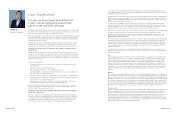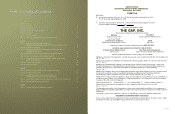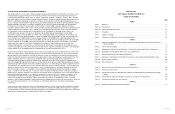The Gap 2007 Annual Report Download - page 14
Download and view the complete annual report
Please find page 14 of the 2007 The Gap annual report below. You can navigate through the pages in the report by either clicking on the pages listed below, or by using the keyword search tool below to find specific information within the annual report.
time. However, our ability to realize the expected benefits of this arrangement is subject to various risks, some of
which are not within our complete control. These risks include disruption in services, the inability to quickly
respond to changes in technology, and the failure to protect the security and integrity of the Company’s data
under the terms of the agreement. We are unable to provide assurances that some or all of these risks will not
occur. Failure to effectively mitigate these risks if they occur could have a material adverse effect on our
operations and financial results. However, we are actively managing the framework of the agreement to align it
with our evolving business needs, which include financial benchmarking, in-sourcing, and adjusting service levels
as appropriate.
Our efforts to expand internationally through franchising and similar arrangements may not be
successful and could impair the value of our brands.
We entered into franchise agreements with unaffiliated franchisees to operate stores in Asia, Europe and the
Middle East. Under these agreements, third parties operate, or will operate, stores that sell apparel, purchased
from us, under our brand names. Prior to fiscal 2006, we had no experience operating through these types of
third-party arrangements, and we can provide no assurance that these arrangements will be successful. While we
expect that this will be a small part of our business in the near future, we plan to continue to increase the number
of countries in which we enter into these types of arrangements over time as part of our efforts to expand
internationally. The effect of these arrangements on our business and results of operations is uncertain and will
depend upon various factors, including the demand for our products in new markets internationally and our ability
to successfully identify appropriate third parties to act as franchisees, distributors or in a similar capacity. In
addition, certain aspects of these arrangements are not directly in our control, such as the ability of these third
parties to meet their projections regarding store openings and sales. Moreover, while the agreements we have
entered into and plan to enter into in the future provide us with certain termination rights, to the extent that these
third parties do not operate their stores in a manner consistent with our requirements regarding our brand
identities and customer experience standards, the value of our brands could be impaired. Failure to successfully
expand internationally through franchising or similar arrangements, or a failure to protect the value of our brands
or any other acts or omissions by a franchisee, could have an adverse effect on our results of operations or our
reputation.
Our products are subject to risks associated with overseas sourcing and manufacturing.
Independent third parties manufacture the majority of our products for us. If we experience significant increases in
demand, or need to replace an existing vendor, there can be no assurance that additional manufacturing capacity
will be available when required on terms that are acceptable to us, or at all, or that any vendor would allocate
sufficient capacity to us in order to meet our requirements. In addition, even if we are able to expand existing or
find new manufacturing sources, we may encounter delays in production and added costs as a result of the time it
takes to train our vendors in our methods, products, quality control standards, and labor, health and safety
standards. Moreover, in the event of a significant disruption in the supply of the fabrics or raw materials used by
our vendors in the manufacture of our products, our vendors might not be able to locate alternative suppliers of
materials of comparable quality at an acceptable price, or at all. Any delays, interruption or increased costs in the
manufacture of our products could have an adverse effect on our ability to meet retail customer and consumer
demand for our products and result in lower revenues and net earnings both in the short and long term.
Because independent vendors manufacture the majority of our products outside of our principal sales markets,
our products must be transported by third parties over large geographic distances. Delays in the shipment or
delivery of our products due to the availability of transportation, work stoppages, port strikes, infrastructure
congestion, or other factors, and costs and delays associated with transitioning between vendors, could adversely
impact our financial performance. Manufacturing delays or unexpected demand for our products may require us to
use faster, but more expensive, transportation methods such as aircraft, which could adversely affect our profit
margins. In addition, the cost of fuel is a significant component in transportation costs, so increases in the price of
petroleum products can adversely affect our profit margins.
The interest on our $500 million notes payable due December 2008, of which only $138 million remains
outstanding, is subject to increase or decrease by 0.25 percent for each rating downgrade or upgrade,
respectively, of our long-term senior unsecured debt ratings by rating agencies. The interest rate on the notes
was 10.05 percent per annum as of February 2, 2008.
Any future reduction in our long-term senior unsecured credit rating could result in reduced access to the capital
markets and higher interest costs on future financings.
For further information on our debt and credit facilities see the sections entitled “Debt” and “Credit Facilities” in our
“Management’s Discussion and Analysis of Financial Condition and Results of Operations” included as Part II,
Item 7 of this Form 10-K.
Trade matters may disrupt our supply chain.
We cannot predict whether any of the countries in which our merchandise currently is manufactured or may be
manufactured in the future will be subject to additional trade restrictions imposed by the U.S. and other foreign
governments, including the likelihood, type or effect of any such restrictions. Trade restrictions, including
increased tariffs or quotas, embargoes, safeguards and customs restrictions, against apparel items, as well as
U.S. or foreign labor strikes, work stoppages or boycotts, could increase the cost or reduce the supply of apparel
available to us and adversely affect our business, financial condition and results of operations. Although the quota
system established by the Agreement on Textiles and Clothing was phased out for World Trade Organization
countries effective January 1, 2005, the U.S. and China agreed to continue with safeguards on textiles and
apparel in China through December 31, 2008. There can be no assurances that additional restrictions will not be
reestablished for certain categories in specific countries. We are unable to determine the impact of the changes to
the quota system on our global sourcing operations, including China and Vietnam. Our sourcing operations may
be adversely affected by trade limits or political and financial instability resulting in the disruption of trade from
exporting countries, significant fluctuation in the value of the U.S. dollar against foreign currencies, restrictions on
the transfer of funds and/or other trade disruptions.
Updates or changes to our IT systems may disrupt operations.
We continue to evaluate and implement upgrades to our information technology systems. Upgrades involve
replacing existing systems with successor systems, making changes to existing systems or cost-effectively
acquiring new systems with new functionality. We are aware of inherent risks associated with replacing these
systems, including accurately capturing data and system disruptions, and believe we are taking appropriate action
to mitigate the risks through testing, training and staging implementation as well as ensuring appropriate
commercial contracts with third-party vendors supplying such replacement technologies are in place. For
example, in fiscal 2007, we implemented the first phase of our new merchandise planning system. The new
merchandise planning system will be rolled out to our domestic operations in fiscal 2008 and 2009. Although we
are on track with replacement or upgrade of our systems, there can be no assurances that we will successfully
launch these systems as planned or that they will occur without disruptions to operations. Information technology
system disruptions, if not anticipated and appropriately mitigated, could have a material adverse effect on our
results of operations.
Our IT services agreement with IBM could cause disruptions in our operations and an adverse effect on
our financial results.
We have entered into the third year of a ten-year non-exclusive services agreement with IBM under which IBM
operates certain significant aspects of our information technology infrastructure, including supporting our
mainframe, server, network and data center, and store operations, as well as help desk, end user support, and
some disaster recovery. Under this agreement, we expect to continue to enhance the capabilities of and level of
service realized from our technology infrastructure, while reducing the costs associated with these functions over
10Form10-K Form10-K11
























